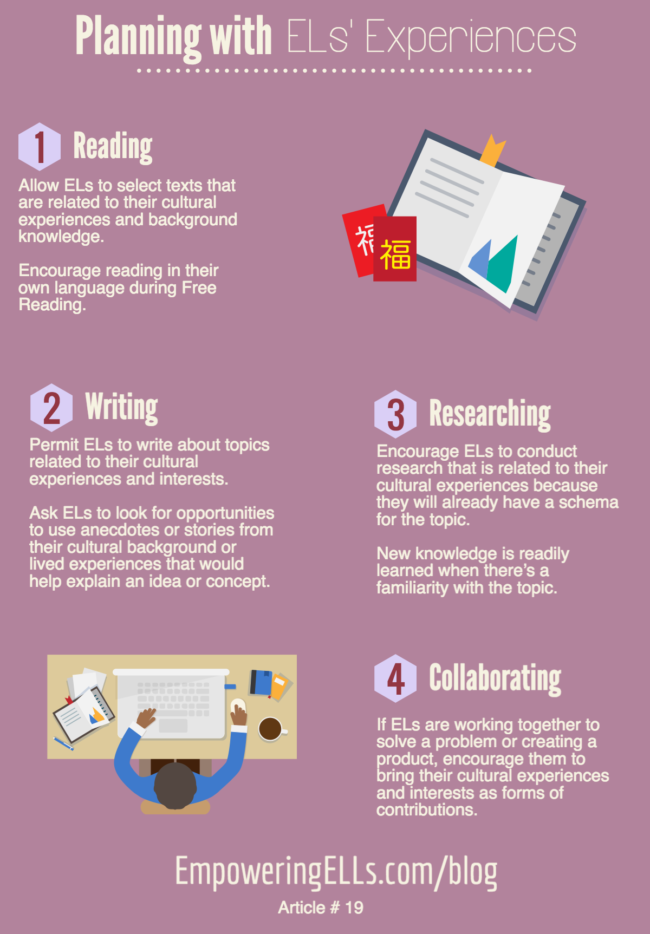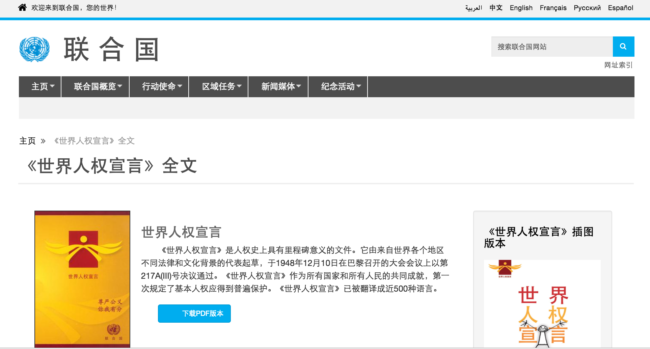Part 1 of WIDA’s Essential Action Series
 Action 1: Incorporating ELs’ Experiences
Action 1: Incorporating ELs’ Experiences
This is the first of 15 articles devoted to sharing practices that WIDA (World-Class in Design and Assessment) (Gottlieb, 2013) has identified as essential to helping ELs develop social and academic language. This set of articles can be found in Essential Actions: A Handbook for Implementing WIDA’s Framework for English Language Development Standards.
The practices range from describing the types of scaffolding that support ELs to explaining how collaborating with content teachers can further ELs academic language and access content. Gottlieb is also the author of Assessment for English language learners: Bridges to equity (2016), another work that you might be interested in reading.
In this series called “Empowering Practices”, I identify the principles in each of WIDA’s 15 Essential Actions. These principles highlight the instructional practices that enable ELs to develop language and facilitate their engagement with content. I will take you through each one and invite you into my classroom to see how I incorporate them into my instruction.
ColorínColorado.org wrote an extensive article on how schools can use the Essential Actions Handbook as a book study in professional learning communities.
WIDA’s Action 1 encourages us to see that our ELs come with lots of life experiences that can be tapped to cultivate their academic language. Action 1 wants us to shift from a deficit-based model of language instruction to an asset-based approach. The purpose of this article is to encourage educators to find ways to welcome ELs’ background knowledge, incorporate their cultural experiences, and use students’ native languages to help ELs connect to class.
Research for Incorporating ELs’ Experiences
- Educators can honor students lives and cultural experiences by setting them as the context for teaching and learning (Gonzalez, Moll, & Amanti, 2005; Moll, 1992).
- Although academic language includes multiple literacies, engaging in one academic language enriches and develops the others. Research suggests that ELLs who have diverse and meaningful experiences in their native language develop literacy faster in a second language (Gottlieb, 2013; Gee, 2008).
- Teachers of ELs can encourage bilingualism by supporting students’ inquiries into their own cultural experiences and their use of multiple languages (Escamilla & Hopewell, 2010, Garcia & Kleifgen, 2010; Hornberger, 2003).
In this article, I’ll show you how I honor this body of research and attempt to include students’ cultures and experiences as a context for learning language. In addition, I recommend reading Laura Lenz’s guest post entitled “A Strength-Based Approach to Teaching ESL” on Jennifer Gonzales’ highly useful Cult of Pedagogy blog . Laura and I both write about adopting an asset-based approach to instruction instead of a deficit model. She provides six reminders to educators on how to validate what ELs can contribute to their communities.
Current Practices: How to Incorporate ELs’ Experiences
There are three areas of EL knowledge that educators can use as context for learning language: cultural traditions, hobbies/Interests, life experiences, national practices. Each of these areas can be integrated in 4 simple ways: reading, writing, researching and collaborating. Students in Garrett’s class were exploring the concept of human rights. They had to report on the different ways that human rights are being denied and describe their impact.
Instead of making students report on a human rights issue selected by Garrett and I, we decided to tap into ELs’ own experiences and cultures. We encouraged students to choose topics they are familiar with that are happening in their own countries. We knew that if they did, their engagement would increase and their focus would more likely be sustained. After all, students’ experiences form a foundation where new learning can be built (Ausubel,1968; Ausubel, Novak, & Hanesian, 1978). Here are some examples of how the students chose to incorporate their worlds into this assignment.
Student Examples
Yinuo, a student from China, wanted to inquire into the right to move both within and out of one’s country. She decided to focus on internal migration in China. Because she was at the Emerging phase of her English language development, I encouraged her to find relevant sources in Chinese to help her access information.
Yinou used this article from Human Rights Watch, which was already translated into Mandarin by the organization, to support her research. We allowed Yinou to use resources in Chinese because we wanted her to first and foremost understand the topic. After all, she could not communicate what she did not understand.
We wanted to use Yinou’s experience and her native language to empower her to communicate ideas, even if she had to do it in broken English. This belief that comprehensible input is required to produce comprehensible output comes from Stephen Krashen (1981). The priority was on her understanding the concept Mr. Garrett wanted Yinou to learn, not on her mastery of English grammar and vocabulary.
By allowing Yinou to use Chinese sources to aid her comprehension of the topic, Garrett and I honored Yinou’s language development. When as her English was more established, we gradually let her use more and more English resources.
We use the same philosophy of incorporating ELs’ experiences to support that academic engagement with Nurul, a Malaysian student. She was interested in the right to marry the partner of one’s choosing. She wanted to explore the perspectives on why Malaysians are only allowed to marry if both partners practice the same religion. Nurul was also encouraged to use sources in Malay to help her research. She found several Youtube videos and two articles in her native language related to the topic.
The Result
Both of these girls were highly engaged in the assignment because they were allowed to explore topics connected to their cultural experiences. Learning had a context, and the concept of human rights became more accessible and meaningful to them when they were encouraged to use their home languages and a research a topic they could identify with.
Just because they used non-English resources does not mean that they were not developing English skills. On the contrary, the assignment required them to organize and communicate their understanding of the topic in English. This made learning academic English even more meaningful precisely because Yinuo and Nurul had to use it to express their ideas.
If there is space and freedom within your curriculum, I encourage you to try to find ways to allow ELs to incorporate their cultural backgrounds and interests as the context for learning content and developing skills. It makes learning more relevant and thereby increases student engagement. The more students are engaged, the more their critical thinking and communication skills flourish.
Can Do Philosophy
Incorporating ELs’ experiences is one of the key elements of WIDA’s Can Do Philosophy. This is a framework that has transformed the way I think about my ELs and the way I talk about them. I has shifted my thinking from a deficit model to one where I describe actions ELs can do instead of negatively focusing on things they can’t. All they can do right now is everything they can do. WIDA’s Can Do Philosophy honors that.
Next Post
To empower ELs to live up to their full potential, we have to explicitly teaching academic language. In the next chapter, I’ll be sharing diagrams that make learning academic language more accessible and visible.
References
Escamilla, K., & Hopewell, S. (2010). Transitions to biliteracy: Creating positive academic trajectories for emerging bilinguals in the United States. In J. Petrovic (Ed.), International Perspectives on Bilingual Education: Policy, Practice, Controversy. Charlotte, NC: Information Age Publishing.
Garcia, O., & Kleifgen, J. (2010). Educating emergent bilinguals: Policies, programs, and practices for English language learners. New York: Teachers College Press.
Gee, J. P. (2008). Social linguistics and literacies. Ideology in discourses. London, UK: Routledge.
González, N., Moll, L., & Amanti, C. (2005). Funds of knowledge: Theorizing practices in households, communities and classrooms. Mahwah, NJ: Erlbaum.
Gottlieb, M. (2012). An overview of language education standards. In Coombe, Stoyno, Davidson, & O’Sullivan (Eds.), The Cambridge Guide to Language Assessment. Cambridge, UK: Cambridge University Press.
Gottlieb, M. (2013). Essential Actions: A Handbook for Implementing WIDA’s Framework for English Language Development Standards. Madison: Board of Regents of the University of Wisconsin System.
Hornberger, N. H. (Ed.). (2003). Continua of biliteracy: An ecological framework for educational policy, research, and practice in multilingual settings. Clevedon, UK: Multilingual Matters.
Krashen, S.D. (1981). Second language acquisition and second language learning. Oxford: Pergamon Press.
Moll, L. (1992). Funds of knowledge for teaching: Using a qualitative approach to connect homes and classrooms. Theory into Practice, 31(2), 132–41.


